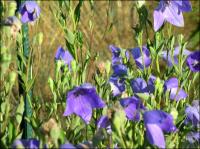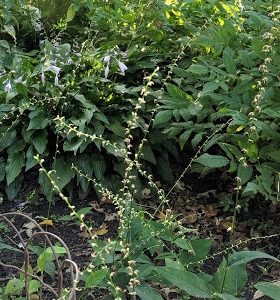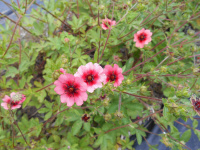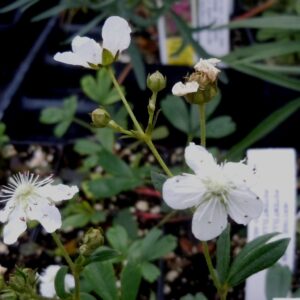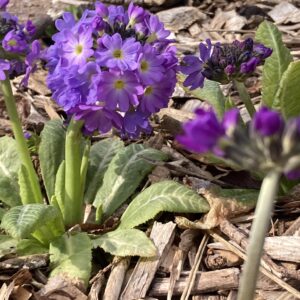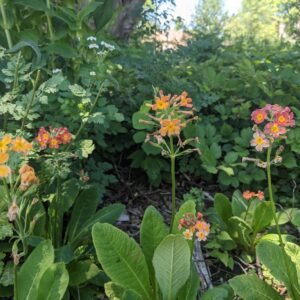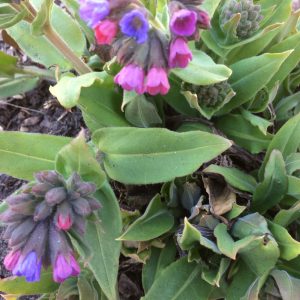Plants for Butterflies and Other Pollinators
Showing 145–152 of 223 results
-
Platycodon grandiflorus Balloon flower Z 3-9
Balloon shaped buds opening to blue bells from mid-summer to early fall.
Balloon shaped buds opening to blue bells from mid-summer to early fall.
Size: 24" x 12"
Care: Full sun to part shade in moist well-drained soil. Heat and drought tolerant. Deadhead for rebloom.
Native: Eastern Asia
Wildlife Value: attracts butterflies, bees & hummingbirds
Awards: Received England’s Royal Horticultural Society Award of Merit.Platycodon is Greek from platys meaning “broad” and kodon meaning “bell”, referring to the shape of the flower. Cultivated in China for hundreds of years where it is called Jie-geng. The Chinese used the root boiled to cure a chill in the stomach. Mentioned in Man’yoshu, a Japanese anthology of poems written in the 8th century. German botanist Johann Gmelin first discovered P. grandiflorus in Siberia in 1754. Gmelin’s Siberian mission, sponsored by Catherine the Great, took 10 years and nearly killed him. Gmelin introduced it to European garden cultivation by 1782. Cultivated in the U.S. since the 1800’s. Received England’s Royal Horticultural Society Award of Merit.
-
Polemonium brandegeei Brandegee’ Jacobs-ladder, Yellow sky pilot Z 4-8
Hanging, tubular yellow, sometimes white blooms over frilly foliage, May-July
OUT OF STOCK
Hanging, tubular yellow, sometimes white blooms over frilly foliage, May-July
Size: 8” x 10”
Care: sun to part shade in very well-drained soil
Native: CO, NM, SD, UT, WY
Wildlife Value: attracts bees, butterflies & mothsCollected by Townshend Stith Brandegee in the ‘Valley of the Rio Grande, on the Los Pinos Trail’ c. 1870. Brandegee then sent it to Harvard botanist Asa Gray who identified and named it to honor its collector.
-
Polygonum virginianum syn. Persicaria virginiana Jumpseed Z 4-8
Arresting tiny white flowers atop nearly leafless stems blooming late summer into fall; dark green foliage marked with a maroon chevron on each leaf
OUT OF STOCK
Arresting tiny white flowers atop nearly leafless stems blooming late summer into fall;
dark green foliage marked with a maroon chevron on each leafSize: 2-3’ x 3-4’
Care: shade to part shade in moist to moist well-drained soil
Native: All eastern areas from central Canada south to Texas, Wisconsin native
Wildlife Value: attracts birds, bees & butterflies, Deer resistant
Size: Cherokee made a hot infusion of leaves with the bark of a Honey Locust to treat whooping cough.Linnaeus 1753.
-
Potentilla atrosanguinea Himalayan cinquefoil Z 5-8
Open pink cups in June-July
Summer to autumn, ruby to pumpkin-colored blossoms shaped like a single petal rose, top pleated silvery foliage.
Size: 18-24" x 24"
Care: Sun well-drained soil
Native: HimalayasPotentilla is Latin meaning powerful referring to medicinal properties. Potentillas used by dentists in the 16th century to reduce pain according to Gerard, English herbalist. Per Culpepper, 17th century English herbalist, potentilla is to be used if Jupiter is ascending and the moon is “applying to him.” Atrosanguinea 1st collected in its native Nepal in 1822. American garden cultivation of this species since mid-1800’s
-
Potentilla tridentata syn. Sibbaldiopsis tridentate Three-toothed cinquefoil Z 2-7
Clusters of white, single rose-like saucer flowers spring and early summer on this dainty-appearing perennial. Its glossy evergreen leaves tinge red in fall and winter.
Clusters of white, single rose-like saucer flowers spring and early summer on this dainty-appearing perennial. Its glossy evergreen leaves tinge red in fall and winter.
Size: 6" x 12" spreading by runners-can become a groundcover.
Care: sun in well-drained, acidic soil
Native: New England to Upper Great Lakes, north to the Arctic, Appalachian Mountains of Georgia, WI native.
Wildlife Value: source of food for Copper butterflies
Awards: Cary Award Distinctive Plants for New EnglandDescribed and named by Kew’s British botanist William Aiton in Hortus Kewensis 1789.
-
Primula denticulata Drumstick primula Z 3-8
Spring-blooming ball, like a lollipop, purple or blue with a yellow eye, atop a leafless scape emerging from a base of wrinkled foliage
Spring-blooming ball, like a lollipop, purple or blue with a yellow eye, atop a leafless scape emerging from a base of wrinkled foliage,
Size: 12-18" x 12-18"
Care: Sun to shade in moist to moist well-drained soil.
Native: Afghanistan, N. Pakistan, across the Himalaya to Yunnan, Sichuan and Guizhou in China.
Wildlife Value: attracts butterflies, Deer and rabbit resistant.Collected by Dr. Frances Buchanan “in moist hills about Chitlong in Nepal.” Exotic Botany, vol. 2 (1805) Sir James Edward Smith (1759-1828) who purchased the huge cache of Linneus’ collection and founder of the Linnean Society. Knighted by Prince Regent for contributions to science.
-
Primula x bulleesiana Candelabra primrose Z 4-7
Blooms June-July, a rainbow of colors ranging from red, orange, rose, to cream, lavender and purple
OUT OF STOCK
Blooms June-July, a rainbow of colors ranging from red, orange, rose, to cream, lavender, and purple
Size: 18-24” x 12-18”
Care: Sun to part shade in moist to wet well-drained soil
Wildlife Value: Attracts butterflies. Deer resistant
Awards: Royal Horticultural Society Award of Garden Merit 1993Hybrid cross between Primula bulleyana and Primula beesiana (both parents are native to the Himalayas and China).
Collected in China, introduced to Britain in 1906 -
Pulmonaria angustifolia Narrow-leaf lungwort, Blue cowslip Z 4-8
One of the earliest to flower - Pink turning azure blue, trumpet-shaped flowers in April- May. Fuzzy foliage.
One of the earliest to flower – Pink turning azure blue, trumpet-shaped flowers in April- May. Fuzzy foliage.
Size: 12”x 18”
Care: full to part shade in moist to moist well-drained soil.
Native: Austria & Hungary.
Wildlife Value: walnut tolerant and deer resistant. Early source of nectar for bees.
Awards: Royal Horticultural Society Award of Garden MeritAngustifolia means “narrow leaves.” But its leaves are only narrow compared to the leaves of other Pulmonarias.
Grown in gardens before 1590’s.

